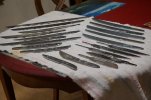You said this was a ken-do type sword, so I assume you are talking Japanese martial arts. Nothing I have seen needs the dimensions you describe unless it was being milled from a solid bar. .375" at the spine (mune) sounds really thick? I don't know the exact sword you want, but I would have picked a bar 36" long, 1.0" wide, and .375" thick to forge a full size blade from. You would likely want 48X2.5X.250 for cutting out the profile and doing stock removal (very wasteful method). Another FYI is they are rarely over 40" long. A photo of your project goal would help.
I'm going to be the spoiler here. It sounds like you have not made a big sword (Japanese or other), and may not have much knifemaking experience or equipment.
A .5X1.75X48 inch bar of steel weighs 12 pounds. .75" would make it 18 pounds.
A full size samurai sword sword goes a couple pounds (3 pounds is heavy). They are rarely over .250" thick at the shinogi. If you want to use it for ken-do, it would need to be in that range. (more later about that)
I can't see any reason to go past .375" stock, with .250" being a good choice if you are doing stock removal.
Grinding a sword with a hand grinder (angle grinder?) will not be pretty. It can be done, but it will take some time and skill. Fullering a long sword also takes some practice. After the basic grinding, you will need a lot of hand filing (draw filing) and maybe 100's of hours of hand sanding to finish a sword like you describe.
You say you need a hamon steel? Doing yaki-ire isn't what most HTers do. It is a difficult skill, and a long sword is not the place to start. A smith with the equipment and experience may charge several hundred dollars just to harden it. Then the togi to finish the blade and bring out the hamon is a second skill set that takes years to master. A togishi may want $2000-3000 to polish out a 40" blade. You can do it yourself, but it take some practice and skill.
Any steel that will take a hamon will make a very sharp edge. That isn't the issue here.
Then there is the koshirae. Will there be a proper tsuka, a saya, fittings? Do you have the skill to make these? Do you have the money to buy them?
Finally - You could make the most beautiful sword anyone ever saw and the old gent and his grandson may love the look ... but it can never be used in any practice or competition. Swords for these uses must be made by someone experienced (and usually certified) for such use. They can cut all the tatami they want at home, but if they take it to a dojo they will be told to take it back to the car.
All the above are concerns for something that will cost a hundreds of dollars in materials - plus HT - plus polishing - plus koshirae - etc. and possibly months in time.
Sometimes it is best to honestly ask yourself if you are ready for such a project. A wise man will listen to his answer. A fool will ignore it.
Hi Stacy, I've been doing the Korean version of kendo for some many years now, and related martial arts. So dojang/dojo etiquette I'm certainly aware of.
Shhh..dont tell anyone but I used to run the place.

When I had a forge and a power hammer I would have made my own, ill use Japanese terms since you know those, sunobe.
So yes I'm aware this is an extraordinarily wasteful exercise.
What I am making take some explanation i suppose.
There are some many variants of katana and tachi, but what apparently gets lost in history is war swords. Dueling katana, at least in my system, are slender and more speedy affair than war katana.
War katana tend to be thicker, wider in style and the grind goes all the way up to the edge.
I am making a fairly famous dueling katana, as a war katana.
The blade is called, the drying pole, most famously wielded by Sasaki kojiro when he lost to Musashi.
History isn't clear whether or not its a straight sword from China, a war jian, or if it is something between katana and nodachi, with a big o-kissaki.
I'm 5'10, 235 lbs. Our system is the Korean equivalent of batto-jutsu. I never liked store bought katana as they were like whippy sticks.
So I need a 48 x .5 x 1.5 because I'm going to cut the shape of the sunobe out.
It will have a longer tang and a 31 inch blade with o-kissaki. So 40 inches would be perfect. But who sells that?
I was fairly good with a power hammer in years past, but that was 20 years ago.
I have a fair bit of hand tooling for metal work and quite the woodshop for wood.
Hope that explains what I want.
My blades final dimensions, naked, with fullering and engraving will be about 2.5 lbs. With the carved bone handle and the brass tsuba(weight relieved of course) I'll be in around 5lbs.
I hope that explains things. I really just want a place I can buy some steel. I'm sure there's a learning curve, but, being locked in during a pandemic and working from home...what is there to do but make swords, hug dogs and drink some soju?

